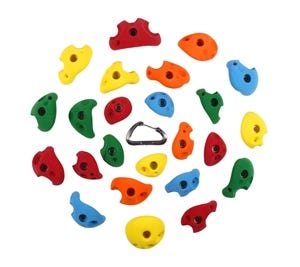The Wall Rock Climdomain_7 Gym
Chances are, if you have kids at home, you flipped through our June issue and stopped in awe at one particularly out-of-this-world playroom. In a San Francisco home designed by Regan Baker, the children have run of the basement, which features a craft room, plush, kids-sized sofas, and, perhaps most impressively, a rope and rock-climbing wall. So how exactly, you might wonder, does one install such an incredible source of amusement in the home? Well, that's where Brita Bookser and Adam Griggs come in. The two avid climbers started Crawl/Stand/Walk, a design studio that devises creative climbing walls for kids and adults alike.
Brita, who has a background in early childhood research and is currently pursuing at PhD at Berkeley, wanted a way to combine her passions of climbing and childhood development, and climbing walls for kids and families seemed the perfect solution. "We like to think climbing is for everyone; all ages, sizes, abilities," Brita says. And with that attitude, she assures that installing one in your own home isn't as hard as it may seem. Here's what you need to know.
No Two Walls Are Alike.
The first part of Crawl/Stand/Walk's process is a consultation with the client. Why? Because climbing walls should vary according to their users. Some questions Brita and Adam consider: "How old are the kids? What are they interested in? What do they do on a playground?" These answers can determine the shape and positioning of the wall, as well as the type of grips you'll use and whether you want volumes (more on those later).
This content is imported from Instagram. You may be able to find the same content in another format, or you may be able to find more information, at their web site.
Adapt to Your Space.
"One of the great strengths in building a climbing wall is that it doesn't have to be complicated and it can be made accessible in all kinds of spaces," Brita says. "You don't need a minimum ceiling height." For lower ceilings, Brita suggests moving out horizontally, or adding volumes, forms that project outward from the wall for added terrain.
Decide Whether to Build Indoors or Out.
You can build a wall inside or out, though Brita notes if it's outdoors, you'll need to ensure it's properly maintained and, if it's freestanding, securely anchored to the ground.

Reinforcement Is Key.
Once you've selected the location, you'll want to make sure the climbing surface is adequately framed, with plenty of reinforcement so it remains secured. Brita recommends regularly spaced 2x4 framing like you'd use with a structural wall.
Use the Right Materials.
Brita recommends using either 3/4-inch or 1-inch plywood (the standard for most climbing gyms) as the top surface on the wall (as Baker points out, the irregularity of plywood means the wall won't appear scuffed). Crawl/Stand/Walk prefers Baltic Birch, which is available at Home Depot.
Position Your Holds.
"The final essential ingredient for a gym-caliber home wall is something called a T-nut," Brita explains. These nuts attach to a piece of wood from behind, so you'll place them anywhere you want to be able to screw in holds. In most climbing walls, these are placed in a grid, 6-8 inches apart, to allow for easy moving and swapping of holds.

24 Divots (Bolt On)
atomik climbing holds atomikclimbingholds.com
$106.98
Not All Holds Are Created Equal.
Speaking of which, Bookser points out, "not all climbing holds are created equal." If you'll be using the wall a lot, or are a more serious climber, you'd be wise to invest in more expensive grips. Crawl/Stand/Walk recommends models from Teknik, So Ill, Atomik, Voodoo, E-Grips, Tension, or Kilter.
Play with Layout.
As your kids grow (or become experts at the current climbing layout), play around with your holds to create new "problems," the climber term for routes across the wall. "After a while—especially for kids, because they learn so quickly—it's great to keep them engaged by coming up with new problems," Brita says.
Replace When Necessary.
Like any often-used product, climbing holds will need to be replaced with age and use. If you use chalk to climb, Brita advises swapping out once holds become covered with chalk.
Learn How to Climb (and Fall!) Safely.
The last point is probably the most important: Always make safety a priority. Brita advises home climbers to line their wall with crash pads (they're usually in place in the Regan Baker home—they were just moved for the photo!). One company, Organic, even makes completely customizable pads. Before anyone uses the wall, Crawl/Stand/Walk will do an introductory safety class with them—if you're DIYing, Brita recommends searching for one of the many YouTube videos that instruct on "falling safe," the practice of rolling on your side when falling off a wall.
Some other tips to always remember: Never walk by or under a person climbing, always have a spotter, and don't have two people climbing the same "problem." Our suggestion to keep this all straight? Make a list of climbing rules to hang by the wall. Then, climb on!
This content is imported from {embed-name}. You may be able to find the same content in another format, or you may be able to find more information, at their web site.
Follow House Beautiful on Instagram .
Hadley Keller Digital Director Hadley Keller is a writer and editor based in New York, covering design, interiors, and culture.
This content is created and maintained by a third party, and imported onto this page to help users provide their email addresses. You may be able to find more information about this and similar content at piano.io
The Wall Rock Climdomain_7 Gym
Source: https://www.housebeautiful.com/home-remodeling/diy-projects/a27914064/how-to-build-rock-climbing-wall/
0 Response to "The Wall Rock Climdomain_7 Gym"
Post a Comment